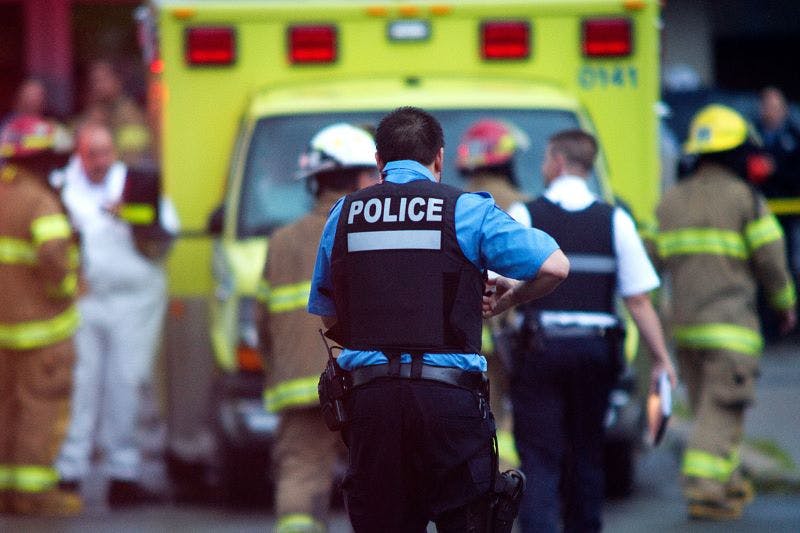Home


Resource Center
Whether they’re law enforcement officers, firefighters, or EMS teams, first responders can often make the difference between life and death for the people who need their services. And first responders depend on mobile data and cell phone technology to do the work that so many people count on.However, there are a number of factors that can block or interfere with the cellular signal that first responders need to do their jobs, including:
- Tall structures and terrain features
- Adverse weather conditions
- Construction materials in dense urban locations or inside buildings
- Distance from the nearest cell tower
- Heavy levels of network traffic
Fortunately, there’s a way to compensate for this — cellular signal repeaters like the solutions offered by WilsonPro.
How Cellular Signal Repeaters Work
A signal booster consists of three critical components:
- A donor antenna that captures an external signal from the nearest tower
- An amplifier that boosts signals both sent to and received by mobile devices
- An inside antenna that distributes the boosted signal inside a building or vehicle
Together these components provide gain (a measure of how much the signal is amplified) and downlink output power (a measure of how much signal the amplifier can retransmit inside a building or a vehicle).
The best signal repeaters work with multiple carriers rather than depending on a single cellular service provider—offering flexibility while providing the strongest possible combination of gain and downlink output power. All of this comes together to provide a stronger, more reliable cellular signal.
Wilson signal repeater systems operate on this principle using proprietary digital technology to deliver the best possible mobile support for first responders.
Benefits of Enhanced Connectivity for First Responders

With the backing of reliable mobile technology, first responders can enhance their operations in a number of critical ways. Having the support they need increases their odds of delivering a positive outcome in any emergency situation.
Here are five of the major benefits that mobile devices with reliable signal, supported by a cell phone signal booster, can provide for first responder teams.
1. Compensation for the Limitations of Two-Way Radio
The most common first responder tool for communication is still the two-way radio. But the same factors that can interrupt cell phone signal can interfere even more dramatically with radio communication. First responders dealing with emergencies have often found themselves operating in radio “dark spots.” In these situations, resorting to their cell phones to coordinate operations provides a critical alternative that can help save lives.
2. Improved Preparedness and Situational Awareness
Mobile technology is useful in supplementing information from radio dispatch centers and control rooms. Providing first responders with access to detailed reports and multimedia can help them understand the current conditions and the incident they’re responding to. This makes it possible to better prepare a response strategy — mitigating risk and maximizing the odds of success if the team has reliable cellular signal.
In addition teams with access to mobile technology can make use of file sharing, video analytics, and online databases while on-site. With the best available information at their fingertips, emergency response teams can communicate more efficiently and better coordinate their efforts.
3. Robust Access to Wireless Emergency Alerts
Strong signal also means being able to access the Wireless Emergency Alert (WEA) network. The WEA is used during critical events to send out threat notifications, AMBER alerts, and other government notices.
Timely access to WEA is crucial for first responder teams, allowing swift and accurate response to rapidly-changing conditions. Without such access, keeping teams updated on the status of developments like shelter-in-place orders can be difficult — and therefore dangerous.
4. Communication and Information Sharing From Almost Anywhere
Mobile devices enable first responders to complete reports, send emails, search databases, and get critical information where it needs to go — in real time. In-vehicle cellular signal repeaters also work to keep GPS devices online, so dispatchers can immediately locate their team.
From any location where there’s available signal to amplify, a signal booster can enhance signal strength. This makes it far easier for teams to stay in touch and provide the most effective emergency services to the public.
5. Access to Real-Time Digital Automation and Reporting
Being able to carry out administrative tasks and compile reports while on the move gives first responders more time to devote to public safety. With access to reliable signal, they can share photos, use automated transcription tools for interviews, and compile real-time insights to create accurate reports

Finding the Best Signal Booster Options for First Responders
It’s important to invest in a cell phone signal booster solution that offers multiple carrier support, powerful gain and downlink output power, and a long service life. Such a device can be the key to taking critical public safety user operations to the next level.
It’s always best to consult with the experts to help determine the right solution for your needs. If your first responder organization is looking for a cell phone signal booster solution for its vehicle fleet, offices, or other structures, reach out to the professionals at WilsonPro. We’ll be happy to discuss your specific requirements and come up with a solution that will improve public safety outcomes for your team.
Contact us today to find out more.

